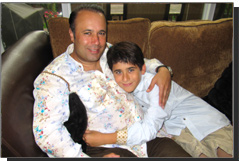



DIR![]() /FloortimeTM
/FloortimeTM
Infants, children, and teens with complex developmental and learning problems, including autistic spectrum disorders, often only learn skills in an isolated, non-purposeful or non-meaningful way (e.g., memorizing scripts). They tend to have a harder time integrating these different capacities meaningfully. An appropriate intervention program must therefore, focus not on isolated skills but on the most essential functional developmental capacities. Specific skills are embedded in these functional developmental foundations. More and more studies are identifying these capacities for shared attention, intimate relating, affective reciprocity, and emotionally meaningful use of actions and ideas as the building blocks for logical and abstract thinking, including higher levels of empathy and reflections.
Our highly trained staff are supervised by DIR® clinicians with extensive training and or certifications in DIR®. Our multidisciplinary DIR® team consists of MFTs, OTs, SLPs, Music Therapists, Educators, Drama Therapists, and Bachelor, Master’s, and Doctorate level Therapists. We provide direct services and parent training in the home, community and center.
What is the Floortime™ / DIR® Model? What does DIR® stand for?
The Developmental, Individual Difference, Relationship-based (Floortime™/DIR®) Model is a framework that helps clinicians, parents, and educators conduct a comprehensive assessment and develop an intervention program tailored to the unique challenges and strengths of children with autism spectrum disorders (ASD) and other developmental challenges.

The objectives of the DIR®/Floortime™ Model are to build healthy foundations for social, emotional, and intellectual capacities rather than focusing on skills and isolated behaviors.
The D (Developmental) part of the model describes the building blocks of this foundation. They include helping children develop capacities to attend and remain calm and regulated, engage and relate to others, initiate and respond to all types of communication beginning with emotional and social affect-based gestures, engage in shared social problem-solving and intentional behavior involving a continuous flow of interactions, use ideas to communicate needs and think and play creatively, and build bridges between ideas in logical ways that lead to higher level capacities to think in multicausal, grey area, and reflective ways. These developmental capacities are essential for spontaneous and empathetic relationships as well as the mastery of academic skills.
The I (Individual differences) part of the model describes the unique, biologically based ways each child takes in, regulates and responds to, and comprehends sensations such as sound and touch and plans actions and ideas. Some children, for example, are hyper responsive to touch and sound, while others are under-reactive, and still others seek out these sensations.
The R (Relationship-based) part of the model describes the learning relationships with caregivers, educators, therapists, peers, and others who tailor their affect-based interactions to the child’s individual differences and developmental capacities to enable progress in mastering the essential foundations.
